There’s no denying that water filters are fantastic at what they do. When you filter your drinking water, you’ll feel confident that you’re not putting anything potentially dangerous into your body while staying hydrated.
The only real issue with a water filter cartridge is its lifespan. The media in a water filter quickly becomes clogged with contaminants. This is a great sign, telling you that the filter is doing its job – but it means that you need to replace the cartridge regularly.
Is it possible to clean a water filter rather than throw it away? In theory, yes. In this guide, we’ll share how to clean a water filter – without the use of chemical cleaners – based on the type of cartridge you own. We’ll also discuss when it isn’t practical to clean a filter, and when you should buy a new one instead.
Table of Contents
📰 Different Types of Water Filters & How to Clean Them
There are four types of water filters that can be cleaned:
- Sediment filters
- Carbon filters
- Reverse osmosis membrane filters
- Refrigerator filters.
Disclaimer: these cleaning methods aren’t guaranteed to work on all filter types. Only attempt to clean a filter if you have a spare backup filter to use if cleaning is unsuccessful.
Sediment Filters
Sediment filter cartridges are typically installed at the point where your water supply enters your home, and are used as standalone filters or pre-filters to large water filter systems.
To clean a sediment filter, you will need:
- An acid (like oxalic acid and muriatic acid)
- Plain tap water
- A clean 1-gallon bucket
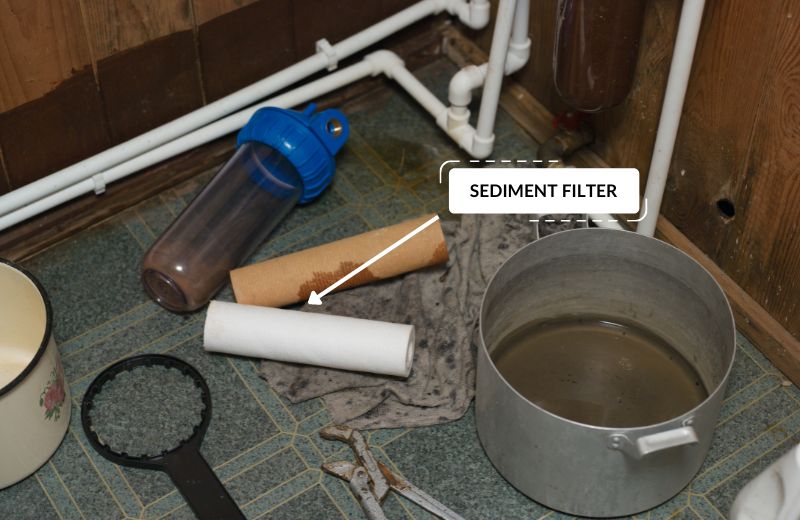
Follow these instructions:
- Remove the sediment filter from the filter housing. Put the o-ring in a safe location.
- If you’ve bought pre-mixed muriatic acid, pour it into the bucket now. If you have oxalic acid, mix the powder with 1 gallon of water in the bucket, as instructed on the packaging.
- Rinse the filter housing, then put it to the side.
- Rinse the filter cartridge under cold water until the filter looks cleaner and the water begins to run clear.
- Put the filter back into the pre-filter housing and soak them in the acid solution for up to 20 minutes.
- Remove the filter and housing from the bucket and rinse them thoroughly under cold water to remove the acid. Let the filter air-dry before attaching the o-ring, slotting the filter back in place, and returning the pre-filter housing to the filtration system.
- Add a couple of tablespoons of baking soda to the acid water to neutralize it before pouring it down the drain.
Carbon Block Filters
Activated carbon filters made from charcoal are a key stage in a multi-stage filtration system, and are used to adsorb chemicals that affect taste and odor, like chlorine.
To clean a carbon block filter, you will need:
- A knife
- A garden hose
- A scrubbing brush
- 1/2 gallon warm water
- 1/2 gallon distilled vinegar
- A medium-sized bucket
- Nylon ties
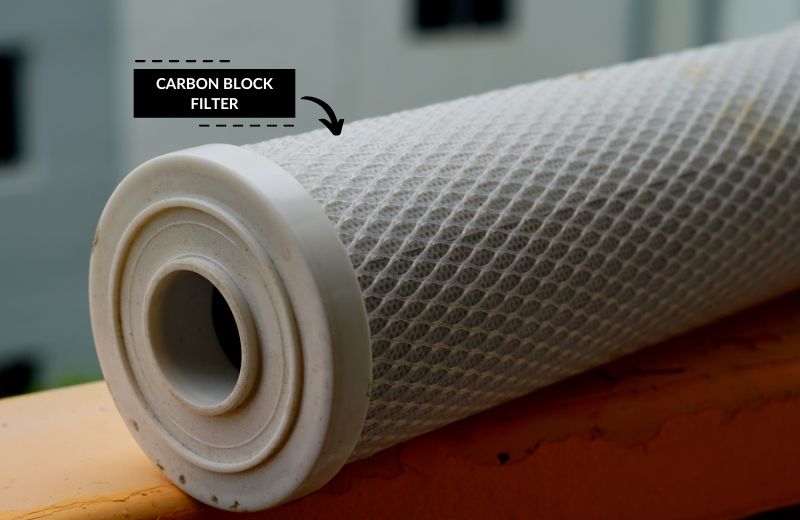
Follow these steps:
- Remove the netting from the outer layer of the activated carbon filter cartridge by carefully cutting around the perimeter of the cartridge with a knife.
- Remove the netting, then cut through the paper layer inside the cartridge. Leave at least 1/2 inch of paper attached to the core of the cartridge so that you can roll the paper back up after cleaning.
- Gently pull the paper to peel it back, then rinse the dirt off the paper and the cartridge’s core with a garden hose.
- Combine half a gallon of warm water with equal parts distilled vinegar. Dip a scrubbing brush in the solution, then use it to scrub both sides of the paper layer.
- Let the filter soak in the solution for up to 60 minutes. Clean the housing during this time if needed.
- Remove the filter from the solution and thoroughly rinse it in cold water. Roll the paper layer back up and secure it in place with nylon ties.
- Let the activated carbon filter dry before returning it to the system.
Reverse Osmosis Membrane Filters
A reverse osmosis membrane filter is the most important stage in a reverse osmosis system. This membrane traps more than 99.9% of impurities (only water molecules can pass through) and lasts up to 2 years.
To clean a reverse osmosis membrane and boost filtration speed, you will need:
- Strap wrench
- RO membrane cleaner
- Bottle brush
- Hot water and dish soap
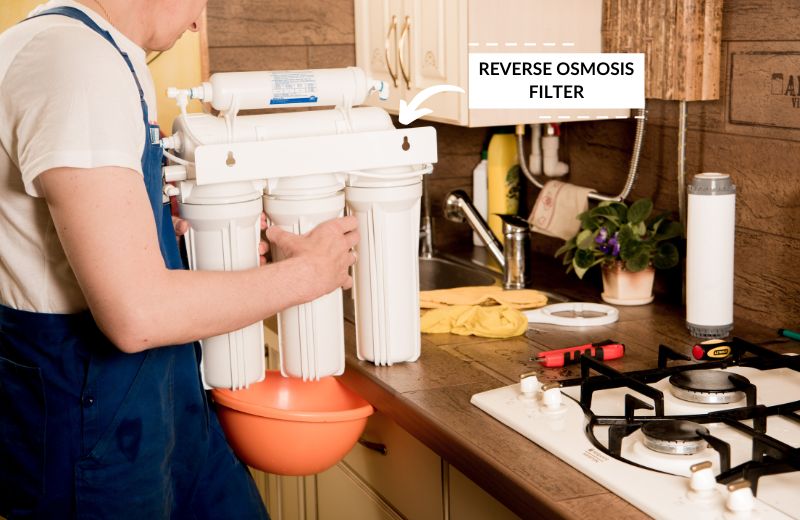
Follow these steps:
- Disconnect the membrane housing from the unit and use a strap wrench to open it. Most reverse osmosis filters are installed at your water line, so divert water away from the system if necessary.
- Drain the water out of the membrane housing and remove the membrane.
- Use a commercial membrane cleaner designed for reverse osmosis systems. Follow the instructions to clean the membrane.
- Use a bottle brush to clean the membrane housing with hot water and dish soap.
- Thoroughly rinse the membrane and the housing, then put them back together and re-attach the membrane housing to the RO system.
- If you plan to clean other reverse osmosis filters, such as carbon filters, clean these separately now.
Note: You will find some advice online that says to clean RO membranes with either low-pH or high-pH cleaners, or a combination of both, depending on the contaminants you want to remove. For instance, acidic chemicals work well to clean organics and mineral scale, while alkaline chemicals can remove bacteria and biofouling.
Using separate cleaning chemicals can be effective, but there’s a risk involved with measuring out your own chemicals. Unless you’re really confident or you’re following your manufacturer’s instructions, we recommend buying an RO membrane cleaner for safer, easier cleaning.
Refrigerator Filters
Refrigerator filters are modular filters that are installed in your refrigerator and provide clean, cool water from your fridge’s dispenser.
To clean a refrigerator filter, you will need:
- Plain water
- A screwdriver
- 1/2 gallon lukewarm water
- Dish soap or distilled vinegar
- A bucket
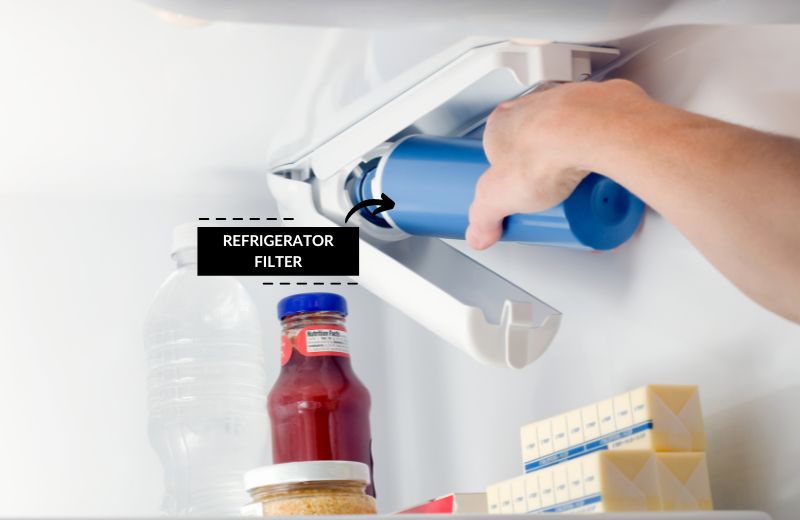
Here’s what to do:
- Remove the filter from the housing and rinse carefully and thoroughly under cold water.
- Tap on the filter with a screwdriver. This will unstick larger sediment.
- Place the filter in a bucket containing half a gallon of lukewarm water and a few drops of dish soap or distilled vinegar.
- Leave the filter for about an hour, then remove it and rinse again until the water runs clear.
- Let the filter air dry on drying rack, then put it back in the housing and re-install it in your refrigerator.
You might also like: Can’t clean your filter? Recycle it instead!
🚿 How to Clean a Brita Filter
Brita filtration systems are a popular way to save money and avoid buying bottled water. Brita cartridges are unique in that they can be replaced with granular activated carbon, so you don’t have to replace the entire cartridge.
To replace the carbon media in a Brita filter, you will need:
- Original Brita cartridge
- Plain water
- New GAC media
- A knife or drill
- Cork or rubber piece
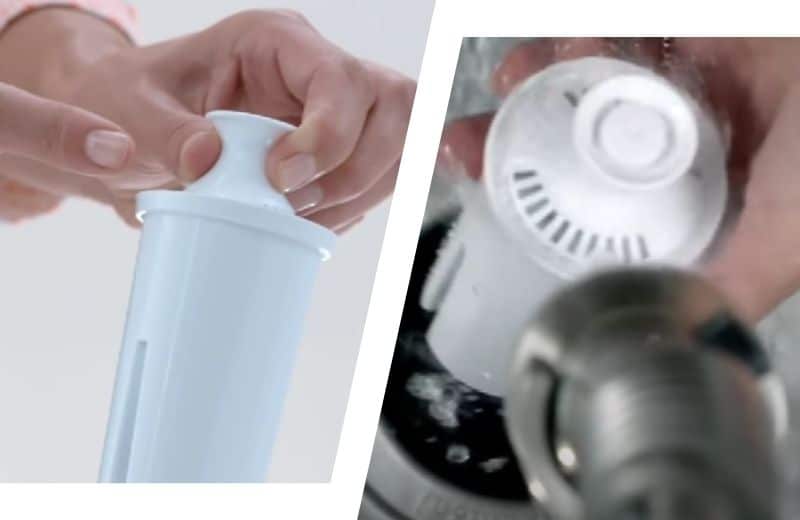
Follow these steps:
- Make a 1/2-inch incision in the middle of the cartridge. You can drill the hole or cut it with a sharp knife.
- Tip the filter upside down over a trash can to pour out all the old carbon media.
- Use clean water to rinse out the inside of the filter cartridge, removing any lingering carbon particles.
- Wait for the cartridge to dry, then carefully pour the new carbon media inside. Use a funnel to prevent spillages.
- Tap the cartridge on a hard surface to settle the media, then seal up the hole with a piece of rubber or cork.
- Re-install the cartridge in the Brita system and follow the usual steps to flush and prime the filter before use.
📤 How to Unclog a PUR Filter
PUR filters are very prone to clogging. This can be caused by an obstruction in the filtration media, or air pockets trapped inside the filter.
Unclogging a filter with air pockets should be easy. Just hold the cartridge upside down and shake it for five seconds. Tap it against a hard surface several times to get rid of any air pockets.
If the blockage is caused by an obstruction in the filtration media, use a faucet sprayer to send water through the holes in the bottom of the filter.
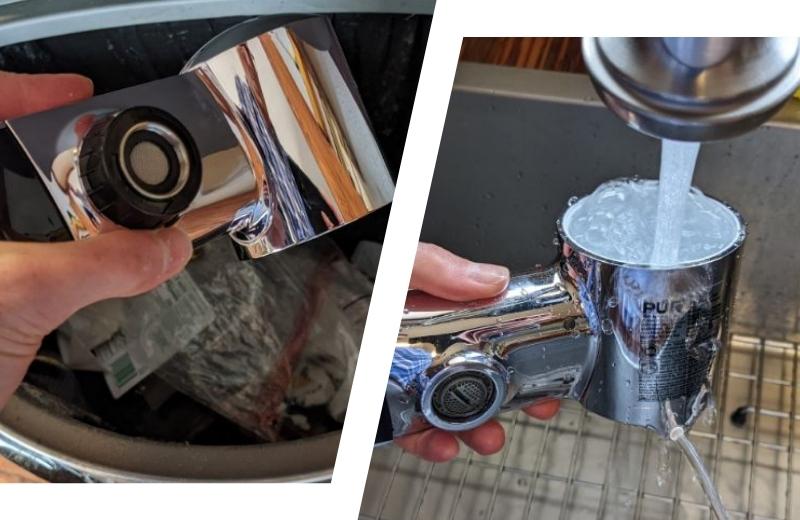
🧼 Is it Safe to Clean a Water Filter?
Some types of water filters can be safely cleaned, while others can’t.
For example, sediment filters made with synthetic fibers are generally safe to clean, while those made with paper are less suited to cleaning. You might end up damaging the filter media, allowing harmful contaminants to slip through.
The supplies you use to clean the filter also affect the safety of the job. We strongly recommend only using natural ingredients to clean your filter, rather than harmful chemicals like bleach.
Remember, your filter is used to treat your drinking water, so you should treat it only with food-safe products that won’t have nasty side effects if you drink traces of them in your water.
🧽 Is Cleaning A Water Filter Worth It?
In some cases, cleaning water filters can extend their lifespan by a few months, reducing the frequency of filter changes. In this case, you may feel that cleaning the filter was worth your time.
Related: How to clean your Berkey filters to extend their lifespan
If you don’t like to put in the effort for menial tasks like cleaning, you’ll probably have a different opinion. For you, spending $40 a year on filter replacements is much easier than spending time cleaning a filter in the hope that it’ll last a few months longer.
In short, it depends on whether you value your time or your money more. There’s no right or wrong answer here!
🧠 How to Clean a Water Filter FAQs
Why do people clean water filters?
People clean water filters to remove the built-up sediment and dirt in the filter media. This frees up space in the media, allowing it to trap more contaminants and essentially giving it a new lease of life. Cleaning a filter also improves water pressure and reduces the frequency that new filter cartridges are needed.
How much longer does a filter last if you clean it?
A cleaned filter could last for one or two months longer than advertised. Keep in mind, though, that most manufacturers don’t recommend using their filters for much longer than advertised because of the potential risk of bacteria buildup.
Can you clean a water filter with vinegar?
Yes. Distilled vinegar is a good ingredient for cleaning a water filter because it’s a powerful cleaner thanks to its acidic nature, and it’s also completely safe and natural to use. When you clean a water filter with vinegar, you can be certain that you won’t add anything dangerous to your water.
How do I remove buildup from my water filter?
To remove a buildup of scale, sediment, dirt, or other contaminants from a water filter, soak the filter in a warm water-vinegar solution. You can find the instructions for specific types of water filter cartridges in the guide above.
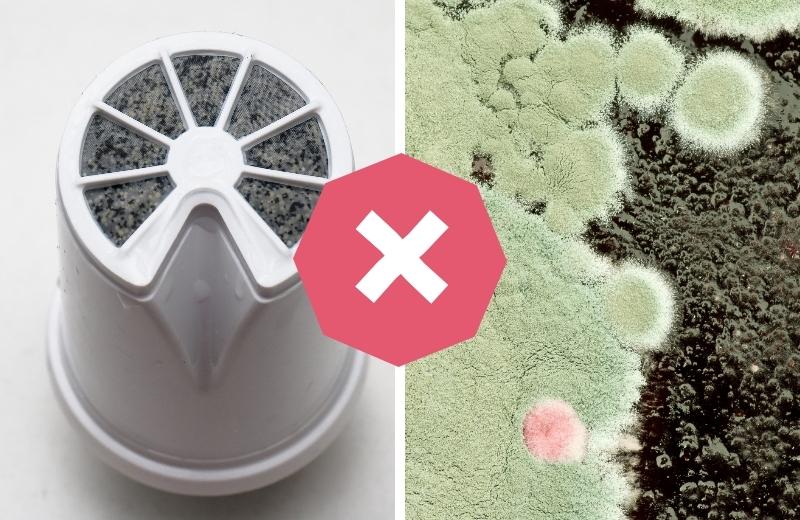
How do you disinfect a filter?
We don’t recommend disinfecting a water filter with a traditional chemical disinfectant, like bleach. These chemicals could damage the filter media or leach into your water in potentially harmful levels. If you want to disinfect a water filter cartridge, follow the instructions in this guide to clean it with warm water and vinegar.
Can water filters make you sick?
Yes. If you don’t replace a water filter as frequently as instructed by the manufacturer, bacteria will begin to grow in the filter. This bacteria may leach into your water, causing gastrointestinal problems, like sickness and diarrhea, in anyone who drinks it. Even cleaning your water filter doesn’t completely eliminate the potential for this bacteria growth in an old filter.
What happens if you don’t flush water filter?
Most filters need to be flushed before use to remove any lingering carbon particles that have become loose during storage or transportation. So, when you don’t flush a filter, you might notice black flecks in your water, and your water might taste or smell unpleasant. It’s not dangerous to drink water from a filter that hasn’t been flushed, but it’s still recommended to flush your filter if the manufacturer recommends it.


Very impressed with everything you put together here. Well done!
I am very new to water filters and never thought I would need one when receiving water from a municipality, but my water is pretty hard. (Use to city water.) I have been using a 1 micron to lower the hardness and replace it monthly. I have recently bought a filter system to try before investing in a water softener (want to see if this would work instead with manual regeneration.)
Any ideal how I would easily clean the following filter without chemicals?
Water Purifier Filtration Purification, Soften Ultration Water Filter, 0.01um 792.52gal/H SUS304 Whole House Water Purifier PVDF
You can check out the product here for more details. I bought the larger unit but have not hooked it up yet. I think I would need to clean it monthly for a house hold of three. 600-1000 gallons a month.
Hey Christopher,
Thanks for the comment! So a surface filter (like your 1 micron filter) will not do anything for the hardness in the water, as these minerals are dissolved and cannot be strained out by a filter of that type. For hardness, the best treatment method is an ion exchange water softener.
The product you mentioned is not capable of softening water or removing hardness minerals.
good article. I have a terrible rust problem and it is very strong. I cannot do my laundry at home because everything comes out ruined with a reddish rust tinge. As filters are a bit on the expensive side..I found your posting quite informative. Thanks M
Hey Maude, thanks for your comment and sorry to hear you are dealing with an iron issue. If the water is visibly red/orange, this indicates ferric iron is present. However there could be ferrous (dissolved) iron as well. Iron is typically treated at the water point of entry to the home, which would ensure clean water to all water based appliances including the washing machine.
I’d advise a complete water analysis to determine what other issues might be present.